15 Epigenetics
We have seen how neurotransmitter action can alter gene transcription and translation through binding to G-protein coupled receptors. The effectiveness of the signaling cascade on new protein synthesis does depend on some DNA-specific factors. This chapter will briefly cover how genes are transcribed and then how non-sequence, molecular changes to DNA can affect transcription rates.
Central Dogma
DNA to RNA to protein. The central dogma of genetics. It may look simple, but many complex steps must occur for the process to be successful.
DNA
Doubled-stranded DNA (deoxyribonucleic acid) is comprised of four nucleotide bases: adenosine (A), thymine (T), guanine (G), and cytosine (C). Adenosine and thymine form base pairs whereas guanine and cytosine form pairs. The pairs cause the two strands to coil around each other and form a double helix.
RNA
The single-stranded messenger RNA (ribonucleic acid) is created from the DNA sequence via complementary base pairing. Like DNA, there are four bases, but in RNA the thymine base is replaced by uracil (U). Messenger RNA (mRNA) leaves the nucleus and interacts with ribosomes to synthesize proteins in a process called translation. The ribosomes pair amino acids to specific three-base sequences called codons. For example, the codon sequence AUG is the start codon and it codes for methionine. The ribosomes will move down the mRNA to find the start codon of the protein and begin translation there, adding a new amino acid for each codon until a stop codon is reached.
Protein
Proteins are synthesized by the linking of amino acids together by the ribosomes. There are 20 amino acids that are each encoded by one or more mRNA codon sequences.
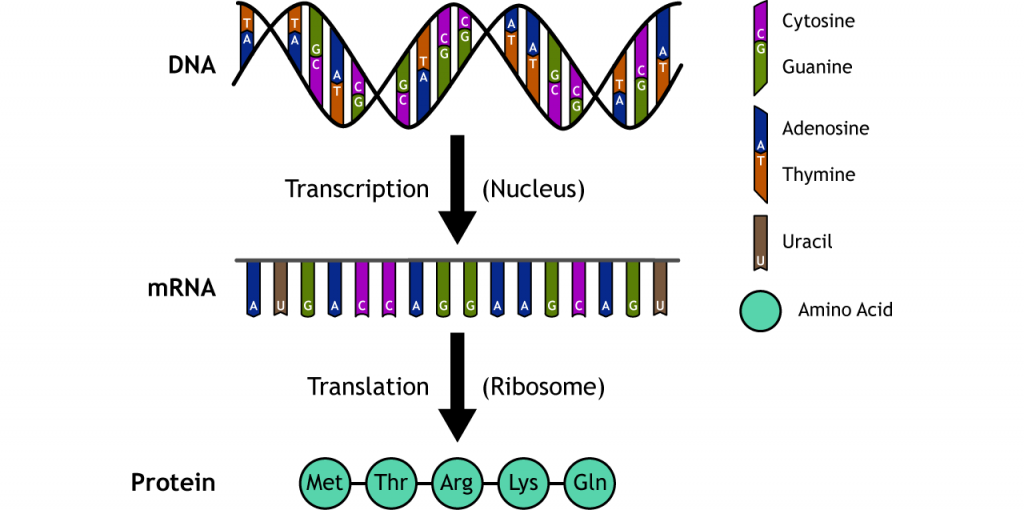
Gene Transcription
In the nucleus, proteins called transcription factors and an RNA polymerase attach to the DNA. The DNA unwinds, the proteins bind, and an mRNA strand is synthesized using the DNA as a template. The mRNA is a complementary sequence to the DNA strand being transcribed.

DNA must be unwound from its condensed form to allow for gene transcription
DNA Packaging
DNA is not always accessible to those transcription proteins, though. There is so much DNA in each cell, that in order to save space, it is highly condensed in the nucleus. The double helix is wrapped around proteins called histones. The histones are then wrapped into nucleosome strands. The nucleosomes are compacted into denser structures called chromatin. Finally, the chromatin is condensed more and creates chromosomes.
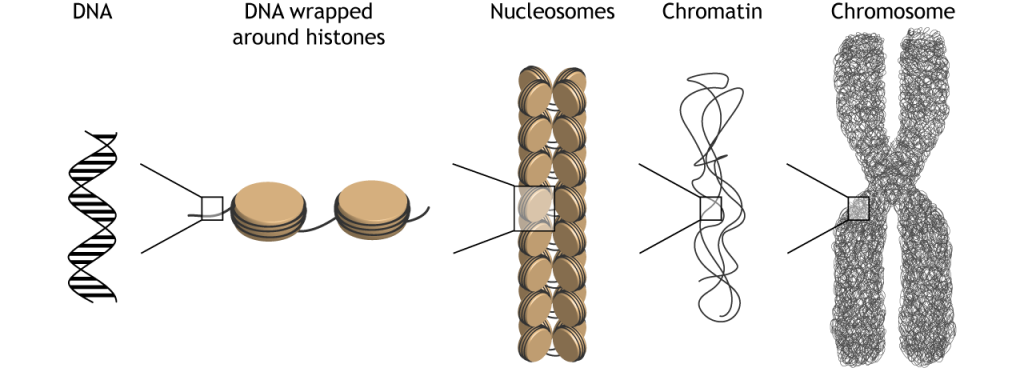
In order for gene transcription to occur, the strands of DNA must uncoil from the histone bodies to become accessible to the transcriptional machinery.
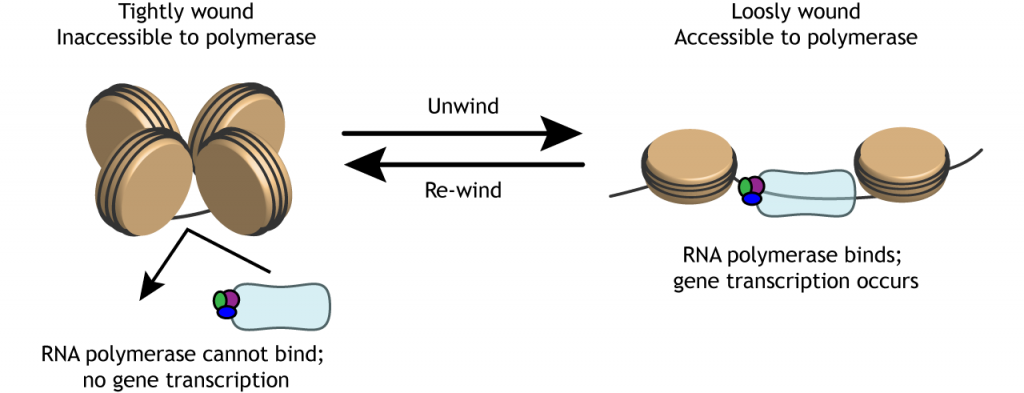
Molecular modifications to the DNA (the epigenome) can alter the ability for gene transcription
Epigenetics
Molecules such as methyl groups can be attached to DNA or on the histones. These epigenetic tags can affect how tightly the DNA is wound around the histones. Since gene expression can be altered by modifying how easily the histones unwind and how accessible DNA strands are, epigenetic tags are able to have an indirect effect on gene transcription.
Methyl groups make it more difficult for the polymerase to access the DNA by keeping the DNA coiled around the histones, reducing transcription. When the methyl groups are removed, called demethylation (not to be confused with dimethylation, the addition of two methyl groups), gene expression can increase because the DNA uncoils and is accessible to the transcriptional machinery.
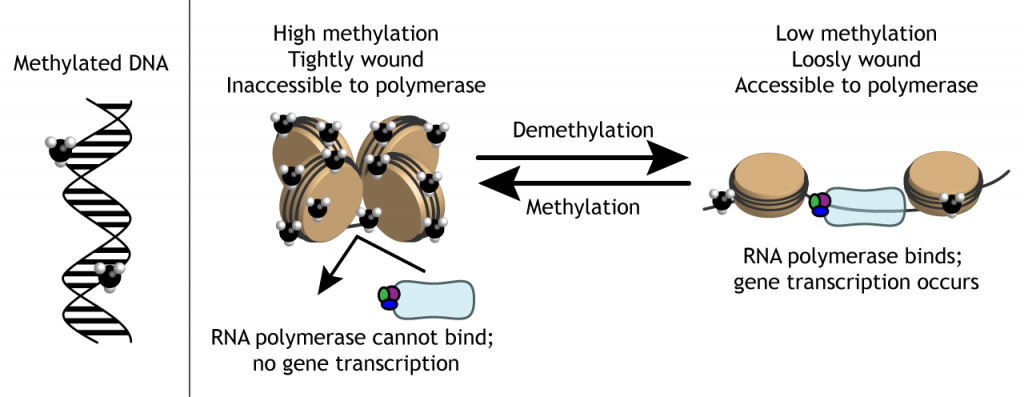
Epigenome is Flexible
An individual’s DNA sequence is fixed (excluding mutations that occur due to damage or errors in cell replication), but the epigenome is flexible and can change throughout life. An individual’s life experiences, especially during development or other critical periods, are able to alter the epigenome.
Some experiences will increase methylation, sometimes for only certain genes, sometimes genome-wide, whereas other experiences will decrease it. For example, early life stress can increase the amount of methylation found on the gene that encodes for the receptor that is activated by stress hormones. Increased methylation leads to reduced transcription which has downstream effects on the negative feedback loop on the stress response. Scientists are starting to realize how important the epigenome is in regulating our brain and behavior.
Inherited Epigenome
Additionally, epigenetic modifications are heritable. Recent research is starting to show that experiences of mothers, fathers, and even grandparents can have transgenerational effects. And these effects, once thought only to be inherited from the maternal side, have now been shown to be paternally inherited as well. This means an animal that had early life stress may have increased methylation and changes in gene transcription that is then passed down for generations even if the offspring do not experience the same stressors.
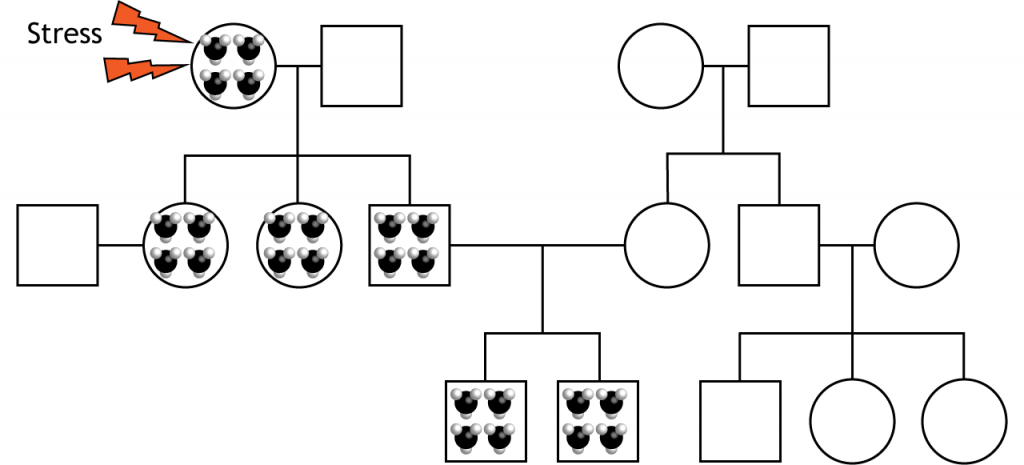
Key Takeaways
- DNA is highly condensed in the nucleus
- The DNA must unwind for transcription to take place
- Epigenetic modifications can alter how easily the DNA can unwind
- Epigenetic modifications can be inherited

